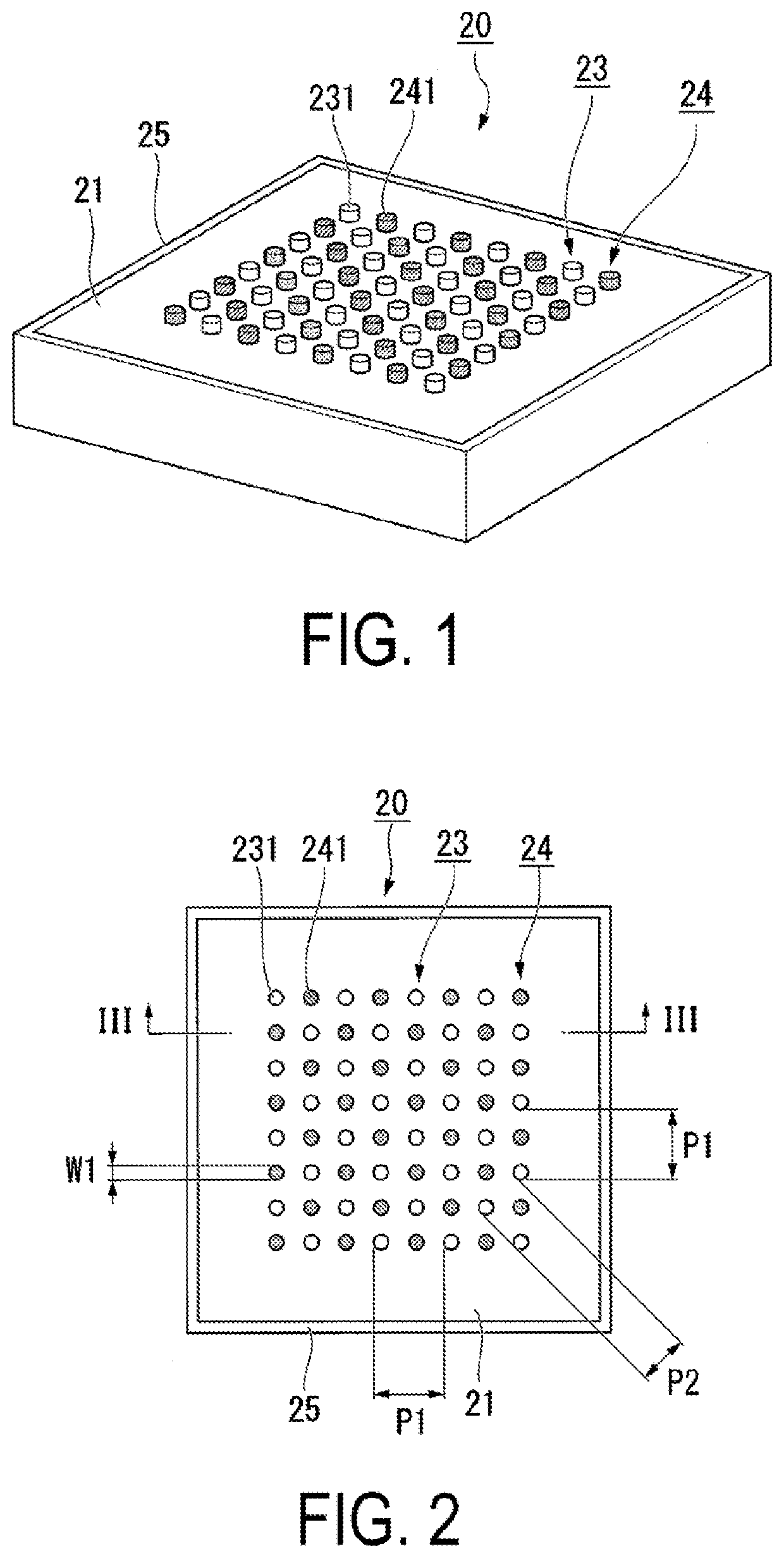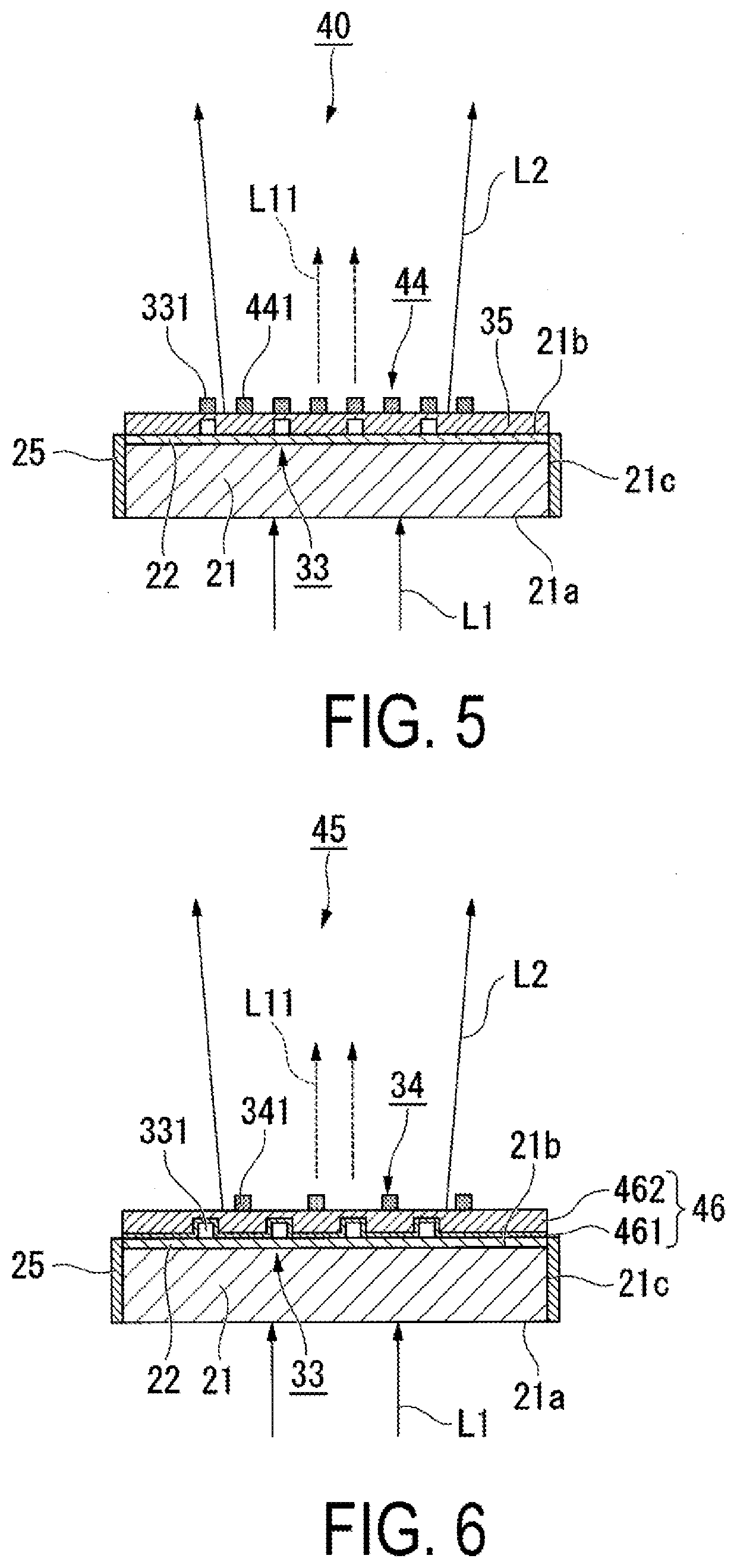Wavelength converting element, light source device, and display device
a technology of light source device and converting element, which is applied in the direction of instruments, lighting and heating apparatus, semiconductor lasers, etc., can solve the problems of reducing the degree of freedom in terms of wavelength selection and radiation angle control
- Summary
- Abstract
- Description
- Claims
- Application Information
AI Technical Summary
Benefits of technology
Problems solved by technology
Method used
Image
Examples
first embodiment
[0037]Below, a first exemplary embodiment according to the present disclosure will be described with reference to FIGS. 1 to 3.
[0038]FIG. 1 is a perspective view of a wavelength converting element 20 according to the first exemplary embodiment. FIG. 2 is a plan view of the wavelength converting element 20. FIG. 3 is a cross-sectional view of the wavelength converting element 20 taken along the line III-III in FIG. 2. Note that, in the drawings, the dimensions of some components may be scaled differently for ease of understanding for the components.
[0039]As illustrated in FIGS. 1 to 3, the wavelength converting element 20 according to the present exemplary embodiment includes a wavelength converting body 21, a first dielectric layer 22, a metallic antenna array 23 (metallic antenna group), a dielectric antenna array 24 (dielectric antenna group), and a light reflection layer 25. Note that the light reflection layer 25 may be a light-absorbing layer, as described below.
[0040]In this d...
second embodiment
[0067]Below, a second exemplary embodiment according to the present disclosure will be described with reference to FIG. 4.
[0068]While a wavelength converting element according to the second exemplary embodiment has a basic configuration similar to that of the first exemplary embodiment, the arrangement of an antenna array differs from that of the first exemplary embodiment. Thus, the entire explanation of the wavelength converting element will not be repeated.
[0069]FIG. 4 is a cross-sectional view of a wavelength converting element 30 according to the second exemplary embodiment.
[0070]In FIG. 4, the same reference characters are attached to constituent elements common to those in the drawings used in the first exemplary embodiment, and explanation thereof will not be repeated.
[0071]As illustrated in FIG. 4, the wavelength converting element 30 according to the present exemplary embodiment includes the wavelength converting body 21, the first dielectric layer 22, a metallic antenna a...
first modified example
[0080]FIG. 5 is a cross-sectional view of a wavelength converting element 40 according to a first modification example.
[0081]In the wavelength converting element 40 according to the first modification example, some dielectric antennas 441 of a plurality of dielectric antennas 441 that constitute a dielectric antenna array 44 are disposed immediately above the metallic antenna 331, as illustrated in FIG. 5. In other words, some dielectric antennas 441 are disposed at positions overlapping with the metallic antenna 331 in plan view. This makes it possible to freely set the pitch of the dielectric antenna array 44 in a manner such that it is narrower than the pitch of the metallic antenna array 33.
PUM
| Property | Measurement | Unit |
|---|---|---|
| wavelength band | aaaaa | aaaaa |
| wavelength band | aaaaa | aaaaa |
| thickness | aaaaa | aaaaa |
Abstract
Description
Claims
Application Information
 Login to View More
Login to View More - R&D
- Intellectual Property
- Life Sciences
- Materials
- Tech Scout
- Unparalleled Data Quality
- Higher Quality Content
- 60% Fewer Hallucinations
Browse by: Latest US Patents, China's latest patents, Technical Efficacy Thesaurus, Application Domain, Technology Topic, Popular Technical Reports.
© 2025 PatSnap. All rights reserved.Legal|Privacy policy|Modern Slavery Act Transparency Statement|Sitemap|About US| Contact US: help@patsnap.com



